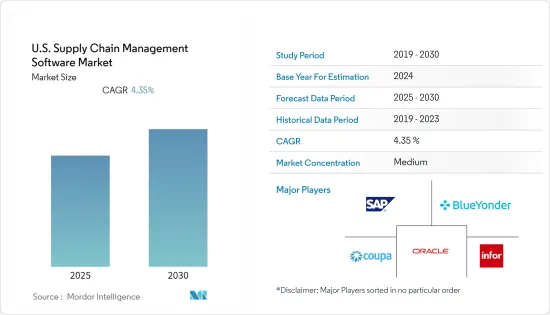PUBLISHER: Mordor Intelligence | PRODUCT CODE: 1644806

PUBLISHER: Mordor Intelligence | PRODUCT CODE: 1644806
U.S. Supply Chain Management Software - Market Share Analysis, Industry Trends & Statistics, Growth Forecasts (2025 - 2030)
The U.S. Supply Chain Management Software Market is expected to register a CAGR of 4.35% during the forecast period.

Key Highlights
- COVID-19 pandemic is expected to trigger a positive demand for supply chain management software in the US, on account of increased logistics supply-demand in the country, especially for FMCG and essential goods.
- Needs for data insights, customer analysis, and all kinds of business processes have strongly increased due to digitization and data collected online by companies. This development drives the demand for Enterprise Software, especially Business Intelligence (BI) Software. Next to BI, Enterprise Resource Planning (ERP), Customer Relationship Management (CRM), and Supply Chain Management (SCM) Software is included in the Enterprise Software segment. In general, Enterprise Software supports the digitization processes of companies and accounts for almost half of total software revenues. CRM is the leading Enterprise Software segment as customer orientation is important in digital business environments to stand out from the competition.
US Supply Chain Management Software Market Trends
Cost Savings Due To SCM Software
- The U.S. supply chain management software is expected to be driven by cost savings caused by utilizing SCM software. With businesses going global and increased competition, supply chains are getting more complex. The number of suppliers, orders received/completed, product offerings, and information generated has increased substantially. Using SCM software would reduce the complexity of the process, cost, and resource savings. The need for companies to remain relevant in the market amidst the highly competitive conditions is a crucial driver for the growth of the SCM software market.
- For instance, Home Depot in the United States, one of the biggest retailers selling home improvement and construction products and services, used to have separate logistics management departments in every single physical store to utilize store management-related activities. This was costly as each store had to process the replenishment orders to get the required materials from the suppliers separately. However, with the help of technology and the right SCM software solutions, Home Depot's new centralized inventory and replenishment department's overall performance improved demand forecast accuracy and decreased the cost of operations for the replenishment orders.
Growth of FMCG Segment
With the onset of COVID-19, many sectors of the economy have experienced a setback, except for FMCG and Pharmaceutical Sectors. These two sectors have experienced an increase in demand as they are a part of the essential goods category. With lockdown restrictions, the Retail eCommerce industry has witnessed a revenue boost. The US Retail eCommerce revenue from food & beverage sales amounted to almost $ 7.3 billion in 2019 and has been increasing since. Amazon had the highest market share among the online food and beverage retailers, followed by Walmart and Kroger. Virtual grocery stores still have higher growth potential as more time-strapped customers look for innovative ways to make their lives easier. However, a significant hurdle for online grocery buys remains freshness, as many customers still prefer to see and touch the product before purchase. To tackle this, Amazon has introduced Amazon Fresh and Prime Pantry, two online grocery shopping services that provide same-day or two-hour delivery. Amazon's food and pantry sales are projected to rise from approximately $ 14.5 billion in 2018 to over $ 23 billion in 2021. Among all the food & beverages categories, Packaged Food segment registered the highest growth percentage, followed by Frozen Foods & Dairy segments.
US Supply Chain Management Software Industry Overview
The United States supply chain management software market is a growing market. The current market share is majorly controlled by a few technology companies that have expertise in providing service solutions in the IT domain. Over the forecast period, market players will be differentiated based on the ability to provide remote access/cloud service in FMCG and healthcare supply chain management at competitive costs.
Additional Benefits:
- The market estimate (ME) sheet in Excel format
- 3 months of analyst support
TABLE OF CONTENTS
1 INTRODUCTION
- 1.1 Study Assumptions and Market Definition
- 1.2 Scope of the Study
2 RESEARCH METHODOLOGY
3 EXECUTIVE SUMMARY
4 MARKET INSIGHT
- 4.1 Market Overview
- 4.2 Industry Attractiveness - Porter's Five Forces Analysis
- 4.2.1 Bargaining Power of Suppliers
- 4.2.2 Bargaining Power of Consumers
- 4.2.3 Threat of New Entrants
- 4.2.4 Intensity of Competitive Rivalry
- 4.2.5 Threat of Substitutes
- 4.3 Assessment of COVID-19 impact on the market
5 MARKET DYNAMICS
- 5.1 Increasing growth in e-commerce, increased acceptance of cloud supply chain management among SMEs, and enhancing business processes are all driving demand for SCM software.
- 5.2 Growing investments by supply chain organizations in applications that support artificial intelligence and analytics capabilities
- 5.3 Market Challenges (Lack of Awareness and Integration Complexities)
6 MARKET SEGMENTATION
- 6.1 By Deployment (Market estimates, forecast (2020-2027), trends and other market dynamics)
- 6.1.1 On Premise
- 6.1.2 Cloud (Insights on SCM SaaS offerings- IoT advantage, automation capabilities, centralized control towers etc.)
- 6.2 By Enterprise Size
- 6.2.1 Small and Medium Enterprises
- 6.2.2 Large Enterprises
- 6.3 By End User
- 6.3.1 Manufacturing
- 6.3.2 Healthcare
- 6.3.3 Fast Moving Consumer Goods (FMCG)
- 6.3.4 Oil and Gas
- 6.3.5 Other End-user Industries
7 COMPETITIVE LANDSCAPE
- 7.1 Company Profiles (Business Overview | Product Portfolio | Financials | Business Strategy And Recent Developments, SWOT analysis)
- 7.1.1 Oracle Corporation
- 7.1.2 Infor Inc.
- 7.1.3 SAP SE
- 7.1.4 Blue Yonder
- 7.1.5 Coupa
- 7.1.6 Manhattan Associates
- 7.1.7 Jaggaer, Inc.
- 7.1.8 E2Open
- 7.1.9 WiseTech Global
- 7.1.10 Descartes Systems Group
8 List of Vendors in Vendor management and procurement space
9 INVESTMENT ANALYSIS
10 FUTURE OF THE MARKET




